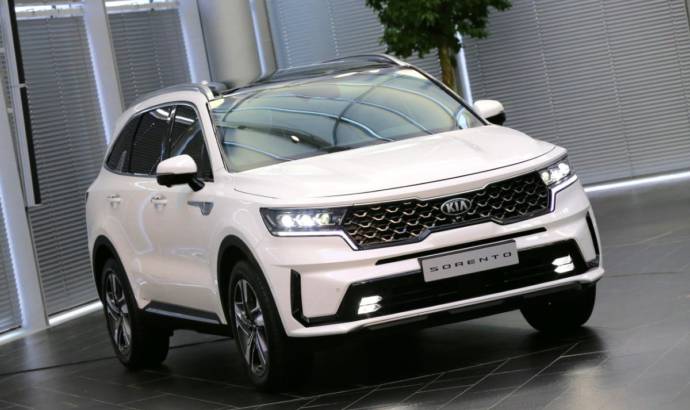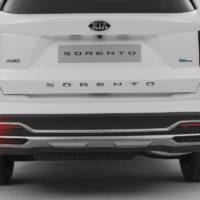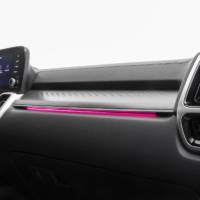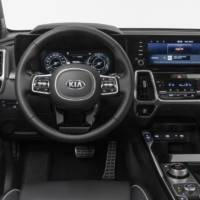After a long teasing campaign, Kia finally unveiled the new Sorento. The Sorento is the flagship for Kia’s reinvigorated global SUV line-up, alongside the Stonic, Seltos and Sportage, as well as the Kia Telluride available in North America and certain other markets. The new model is the result of a collaborative design effort by Kia’s worldwide design network.
The front of the Sorento evolves with a new interpretation of Kia’s hallmark ‘tiger nose’ grille, displaying a wider shape which organically wraps around the integrated headlamps on each side. The headlamps themselves feature a new ‘tiger eyeline’ LED daytime running light, adding extra focus to the design by depicting the intense impression of the lines around a tiger’s eyes. This sharper, more assertive appearance is complemented by a wide, rectangular lower air intake, bookended by wing-shaped air curtains to channel air around the car. A sharp bumper lip is also capped with a skid plate, enhancing its robust appearance. The new model is 1,900mm wide, 10mm wider than the third-generation Sorento.
The Sorento will be available in Europe with a choice of 10 paint finishes, and the option of 17-, 18-, 19- and, for the first time in the line-up, 20-inch aluminium alloy wheels. UK specification will be announced in due course.
The 12.3-inch digital driver instrument cluster is twinned with a 10.25-inch touchscreen infotainment and navigation system at the centre of the dashboard. These display information clearly within the driver’s line of sight, and create an innovative wide-screen user experience. The car’s many functions can also be controlled with new haptic buttons on either side of the screen, which also feature further down the dashboard for the climate control system. The focal point of the dashboard is the eye-catching vertical ventilation stack, with a chrome-effect surround that extends onto the centre console below.
The new platform is based around a compact engine bay structure and shorter front and rear overhangs, with a 35mm longer wheelbase creating greater cabin space between the axles. Not only does this enable the new model’s stylish, more swept-back design; the structure and layout of the new platform means the Sorento is able to accommodate electrified powertrains for the first time.
The Sorento Hybrid’s battery pack is located under the floor of the cabin. As a result, the SUV offers generous space for up to seven passengers as well as one of the largest luggage capacities in its class – up to 821 litres (for seven-seat models) or 910 litres (for five-seat models), depending on specification. This means the car can accommodate five people in comfort, and a significant amount of luggage. In seven-seat models, with all seven seats in place, boot space is also increased by 32 per cent compared to its predecessor, to 187 litres (VDA, diesel models; 179 litres for Hybrid models). Controls in the side wall of the boot also let users fold down the second-row seat backs remotely at the touch of a button.
The Sorento Hybrid is powered by a new ‘Smartstream’ electrified powertrain, pairing a 1.6-litre T-GDi (turbocharged gasoline direct injection) with a 1.49kWh lithium-ion polymer battery pack and 44.2kW electric motor. The intelligent packaging of the Sorento’s new platform means the battery pack can be located under the floor, with minimal impact on cabin or luggage space.
Producing 230ps and 350Nm torque, this electrified powertrain combines low CO2 emissions with high levels of performance. The new 1.6-litre T-GDi engine features Kia’s new Continuously Variable Valve Duration (CVVD) technology, regulating valve opening time according to driving conditions, instead of operating on a fixed opening time. This boosts performance at low-to-mid engine and enhances fuel efficiency.
The Sorento Hybrid will go on-sale in select European markets from launch, with others to follow later in 2020. The Sorento will also be available as a Plug-in Hybrid variant from late in 2020.
The Sorento’s new four-cylinder 2.2-litre ‘Smartstream’ diesel engine is also available for European customers, producing 202ps and 440Nm torque. With a new aluminium block, 19.5kg lighter than the cast iron block of its predecessor, the new engine is 38.2kg lighter compared to that found in the third-generation Sorento. Furthermore, it is paired with Kia’s new eight-speed wet dual-clutch transmission (8DCT). Designed to offer the smooth shifting characteristics of a conventional automatic, the 8DCT enhances fuel efficiency over a conventional eight-speed automatic, depending on application.
Fuel efficiency and emissions data for the Sorento’s new powertrains will be announced closer to the car’s European on-sale date later in 2020.
Like its predecessor, the Sorento will be built for Europe and many other markets at Kia’s Hwasung manufacturing facility in Korea. The car will also be built for North America at Kia’s West Point, Georgia, USA production plant.
European sales are due to commence in the third quarter of 2020; the car will be available to order in most of Kia’s global markets by the end of the year. It will be sold in Europe with Kia’s unique seven-year, 100,000-mile warranty as standard. The UK on-sale date, pricing and specification will be announced in due course.







